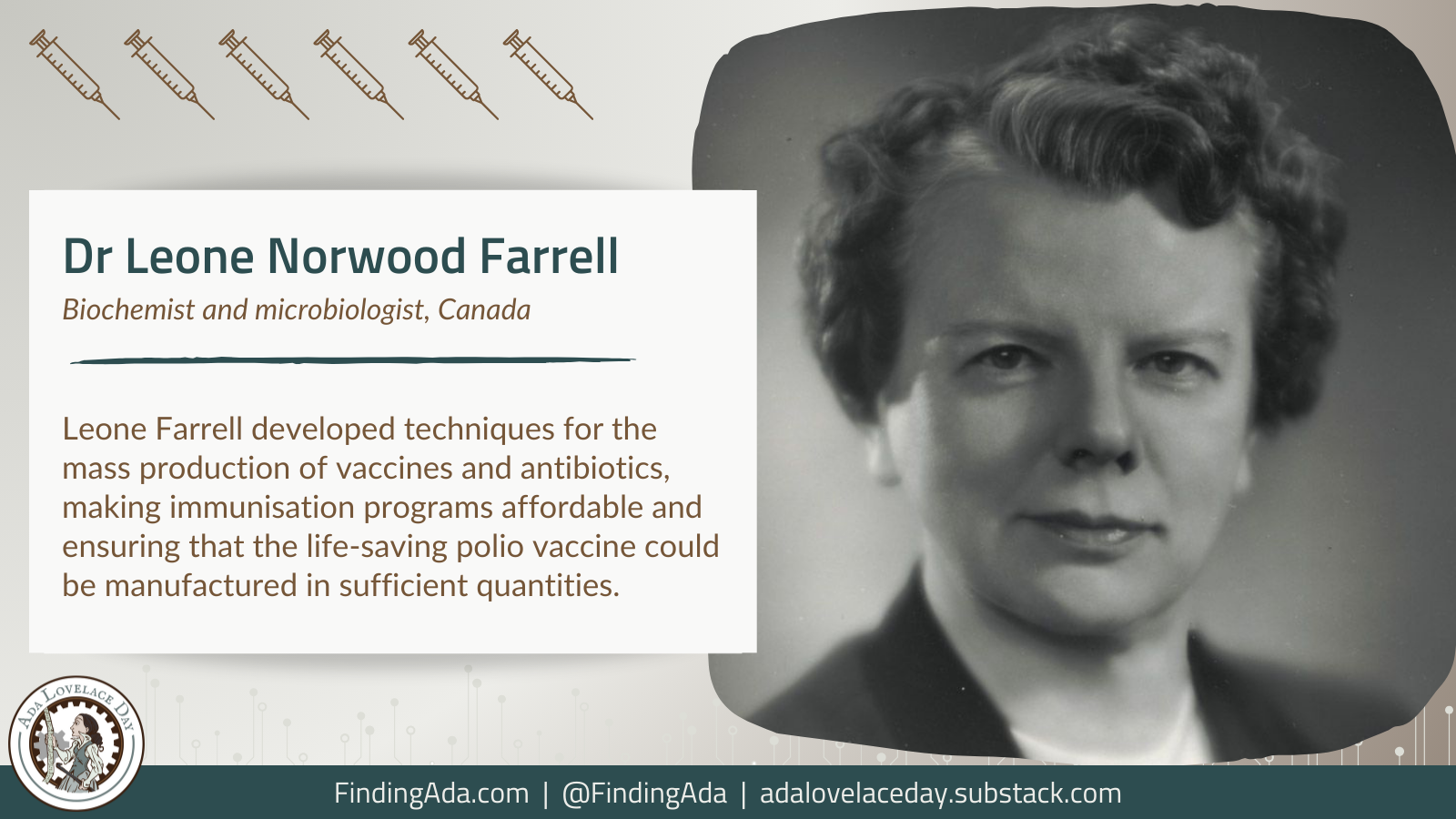Dr Leone Norwood Farrell
Dr Leone Norwood Farrell was a Canadian biochemist and microbiologist whose inventions enabled the large-scale production of the polio vaccine in the 1950s. Her innovative research also helped increase the production of penicillin and sped up the rollout of vaccinations against whooping cough.
Farrell was born in Monkland, Ontario, on 13 April 1904. She studied chemistry at undergraduate level, going on to an MSc in zymology (the chemistry of fermentation) and a PhD in biochemistry at the University of Toronto. In 1934, the year after she obtained her doctorate, Farrell was hired as a research assistant by the university’s Connaught Laboratories. It was a career move that would change her life.
Connaught was a public-service lab that prepared essential health products such as antitoxins, insulin and vaccines. Farrell initially worked on toxoid vaccines for staphylococcus and dysentery, but in 1939, she began developing a new method of growing bacterial cultures in large bottles. These were gently rocked to promote cell growth, significantly increasing the amount of bacteria and toxins that could be cultivated for use in vaccines.
In the early 1940s, Farrell adapted her technique – later known as the “Toronto Method” – to produce a vaccine for pertussis (whooping cough) on a far larger scale than had previously been possible. This made childhood immunisation programmes much more affordable, a remarkable achievement in its own right. Towards the end of World War II, she also identified a strain of penicillium that helped boost antibiotic production.
But it was during the development of the polio vaccine in the early 1950s that Farrell’s rocking technique became truly transformative. The American virologist Dr Jonas Salk had found a way of providing immunity against polio, by injecting people with a killed version of the virus. However, he was struggling to create the vaccine in significant quantities. From 1953, Farrell and her team began adapting the Toronto Method to safely mass-produce the live polio virus, which was then shipped to the US and killed for use in Salk’s research.
To prepare for an unprecedented mass field trial of Salk’s polio vaccine, Farrell oversaw the hiring and training of staff and the custom-building of machines capable of rocking bottles containing 3,000 litres of the virus. At the time, hers was the only team in the world capable of working at such a rate. The trial began in April 1954, with the result made public a year later, the day before Farrell’s 51st birthday. The vaccine worked. “I could not help feeling that I had received a pretty fine present,” she said later.
After that triumph, Farrell returned to her life-saving research into diseases, studying how the polio vaccine could be improved and researching issues surrounding vaccine production and immunity. She published scientific papers until her retirement from the Connaught in 1969, but never sought or achieved Salk’s global celebrity. She died on 24 September 1986 and was buried in an unmarked grave. In 2009, a family tombstone was updated with her name and a tribute to her work.
Variations of the Toronto Method were reportedly used until the 1970s to make polio vaccines; Connaught never patented the process, apparently at Farrell’s request.
Further Reading
- Leone N. Farrell, Wikipedia
- Leone Norwood Farrell, PhD, Carol K. Elliott, Polio Place, March 2011
- Leone Norwood Farrell, Christopher J. Rutty, The Canadian Encyclopedia, 18 March 2021
- Canada’s Key Role in Creating a Once Awaited Vaccine, Ian Austen, The New York Times, 31 July 2020
- Biochemist rocked poliovirus into vaccine, Susanna McLeod, The Kingston Whig-Standard, 16 July 2020
Written by Moya Crockett, with thanks to Stylist for their support.
